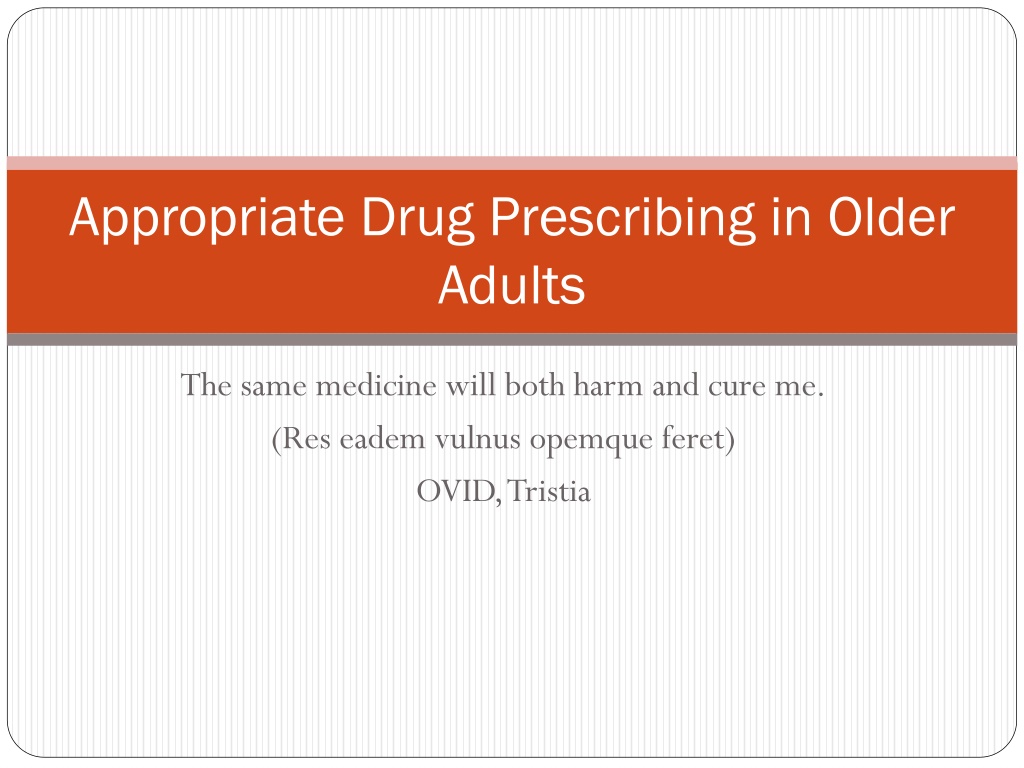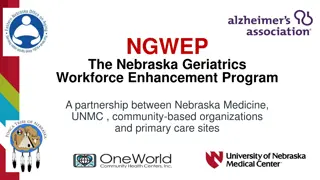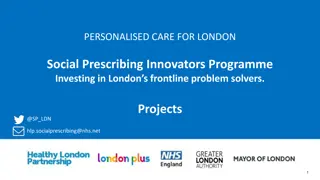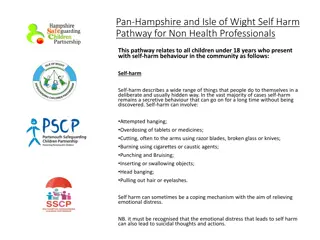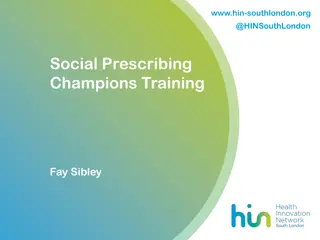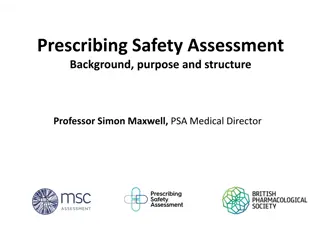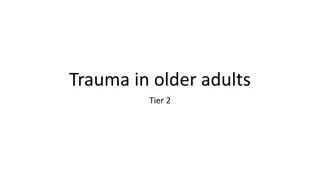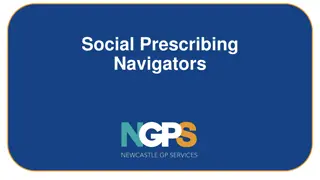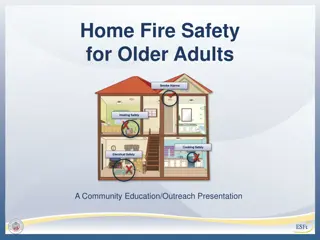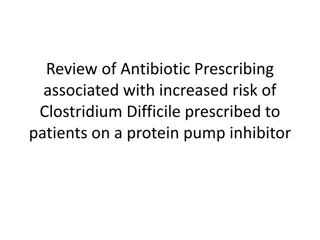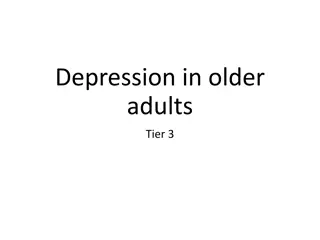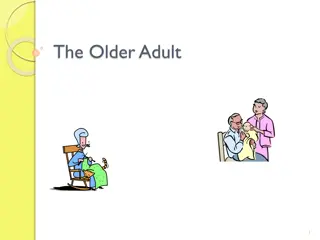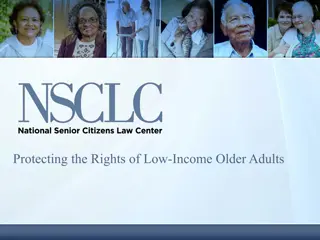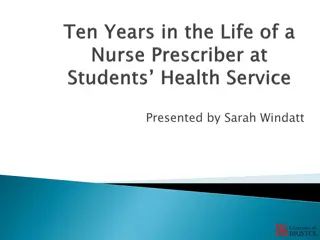Appropriate Drug Prescribing in Older Adults: Balancing Harm and Cure
Understanding age-related changes in pharmacokinetics and pharmacodynamics is crucial for appropriate drug prescribing in older adults. Recognizing high-risk medications to avoid, understanding common drug interactions, and conducting regular drug list reviews are key components in providing safe and effective care. This case study demonstrates the positive impact of appropriate medication management on an older adult with multiple comorbidities, resulting in improved mental status, sleep, continence, gait, and overall well-being.
Download Presentation

Please find below an Image/Link to download the presentation.
The content on the website is provided AS IS for your information and personal use only. It may not be sold, licensed, or shared on other websites without obtaining consent from the author. Download presentation by click this link. If you encounter any issues during the download, it is possible that the publisher has removed the file from their server.
E N D
Presentation Transcript
Appropriate Drug Prescribing in Older Adults The same medicine will both harm and cure me. (Res eadem vulnus opemque feret) OVID, Tristia
Objectives Understand age-related changes in pharmacokinetics and pharmacodynamics Recognize high risk medications which should generally be avoided in older adults Recognize common drug-drug interactions in older adults Perform a quick drug list review and revision using these principles
The same medicine will both harm and cure me. (Res eadem vulnus opemque feret). OVID, Tristia, Book II, L. 20 Good medicine is man s salvation. Excessive use gives aggravation. Romanoff, Alexis Lawrence; Encylopedia of Thoughts, Couplets Formerly, when religion was strong and science weak, men mistook magic for medicine; now, when science is strong and religion weak, men mistake medicine for magic. Szasz, Thomas; The Second Sin, Science and Scientism (p. 115) The desire to take medicine is perhaps the greatest feature which distinguishes man from animal. Osler, Sir William; In Harvey Cushing, The Life of Sir William Osler, Volume I (p. 342) Frequent changes of medicines proclaims the ignorance of the physician and is calamitous for the patients. Hoffman, Friedrich; Fundamenta Medicianae, Therapeutics, Chapter I, 37 (p. 137)
Case Presentation Patient S.L. is a 68 year old female with lifelong mental illness including institutional care. She is brought for evaluation of possible dementia. Current symptoms include fluctuating mental status, gait disorder, falls, urinary incontinence, daytime hypersomnolence and nocturnal sleep disturbances. PMH includes DM type 2, HTN, Dyslipidemia, (?) Schizophrenia, Urinary Incontinence, Unspecified GI disorders (?gastroparesis) Slept through parts of the interview. Exam notable for pedal edema, unsteady gait, parkinsonism
Case Presentation: Medications Prevacid Lantus Insulin Sliding Scale Insulin QID Metformin (BID) Allegra Aspirin Lasix (BID) Potassium chloride Lisinopril Synthroid Fosamax Advair (BID) Effexor (not XR takes BID) Lipitor Metoprolol Nexium Actos Reglan (QID) Ambien Alprazolam (up to QID) Cozaar HCTZ Abilify Metamucil Skelaxin Colace Albuterol Risperdal
Case Presentation Patient returns in 8 weeks Improved mental status and sleep No longer incontinent Improved gait Improved mood Daughter states the best health my mother has been in during her entire life
Background What is the role of the internist or PCP? What do our patients want from us? How is geriatrics different from internal medicine? Are all geriatric patients the same? Polypharmacy is a common reason for patient dissatisfaction and for seeking geriatrics consultation
Background Medicine has largely become the practice of drug prescribing Signs and symptoms reflexively trigger a change in pharmacologic management Increasing emphasis on preventing iatrogenic injuries and improving safety Increasing emphasis on implementing various guidelines for diseases Non-pharmacologic interventions are often available but difficult to implement
Target Population for This Discussion The oldest old (over 75-80) All patients with impaired cognition Patients taking psychoactive medications Patients with depression Patients with history of falls, abnormal gait, or hip fracture Patients with weight loss Patients with incontinence and constipation Nursing home residents
Categories of Drug Related Problems Categories of Drug Related Problems Polypharmacy Adverse drug reactions (ADR s) Subtherapeutic drug dosage Overdose Failure to receive a prescribed drug Adverse effect of drug withdrawal Drug use without an indication Duplication of drug therapy Drug-Drug interaction Underuse of beneficial therapies
Polypharmacy No absolute definition Not necessarily inappropriate Medications can accumulate over decades Every old and new medication taken should be questioned Avoid using medications to treat adverse effects of other medications
Adverse Drug Reactions: Risk Factors Increasing age Increasing number of prescriptions Female Lower body weight, Hepatic or renal insufficiency History of prior drug reactions
Altered Drug Metabolism and Effects with Aging Pharmacokinetics How the body handles a particular drug Absorption Distribution Metabolism Elimination Pharmacodynamics How the target responds to the drug Drug-Drug Interactions Drug-Disease Interactions Diminished organ reserve
Pharmacokinetics & Aging Absorption: Minimal effects from aging Distribution (volume of distribution Vd): Decreased LBW and body water with age Decreases Vd of drugs distributed to muscle or water (aminoglycosides, ethanol, some antibiotics and anti-arrhythmics), resulting in higher peak levels Increases Vd (reservoir) of drugs distributed to adipose (amiodarone, diazepam, haloperidol) Particularly important for loading doses Protein Binding: Often decreased in older patients Can result in higher free levels, particulary if displaced by another protein bound drug (warfarin and aspirin) Measured total serum level may be low but free level is still therapeutic Probably affected more by drug interactions or disease than age per se
Specific Concerns in LTC Institutionalized elderly use more medications than any other group Average resident takes 7 different medications daily 2/3 of patients will have an ADR Patients have multiple illnesses High rates of cardiovascular disease and dementia
Case Discussion Scenario You are the physician for a skilled nursing facility and have accepted a patient who is transferred from the hospital for rehabilitation following a hip fracture. The following discharge summary and medication orders are sent in transfer. You are responsible for signing off on the orders, and decide to review her medications and make any changes you feel are appropriate. Discharge Summary: The patient is a 78 year old female with a past medical history significant for Class III CHF, atrial fibrillation, urinary incontinence, CAD, and GERD - admitted 8 days ago with a right hip fracture. Her hospital course was complicated by a urinary tract infection and acute agitated delirium. Most recent labs prior to discharge notable for Hgb 9.8, MCV 88, INR 2.9, Cr 1.4. Medication orders: 1. Captopril50mg po TID 2. Warfarin 8mg po daily 3. Iron sulfate 325mg po TID 4. Aspirin 81mg po daily 5. Darvocet N-100 1-2 po q4-6H PRN pain 6. Metocloperamide 10mg po qAC and qHS 7. Oxybutnin 5mg po TID 8. Ciprofloxacin 500mg po BID 9. Fluoxetine 20mg po daily 10. Furosemide 20mg po BID 11. Tylenol 1000mg po QID PRN 12. Ultram 50mg po TID 13. Digoxin 0.25mg po daily 14. Amitryptiline 50mg po qHS for insomnia 15. Haloperidol 5mg IV q4H PRN 16. Phenergan 25mg po/pr q6H PRN NKDA On your exam: vitals normal with a regular pulse. Patient is confused and agitated, has difficulty cooperating with the examination. The lungs are clear bilaterally. There is fullness and tenderness in the suprapubic region with hypoactive bowel sounds. You note rest tremor in both upper extremities with some rigidity. There are stage 1 pressure changes in the sacral region (nonblanching erythema). Your task: Identify the potential problems with this medication regimen. Potential problems include dosing errors, adverse drug effects, contraindicated medications, ineffective medications, and absence of potentially beneficial medications.
MEDICATION LIST 9. Fluoxetine 20mg po daily 10. Furosemide 20mg po BID 11. Tylenol 1000mg po QID PRN 12. Ultram 50mg poTID 13. Digoxin 0.25mg po daily 14. Amitryptiline 50mg po qHS for insomnia 15. Haloperidol 5mg IV q4H PRN 16. Phenergan 25mg po/pr q6H PRN 1. Captopril 50mg poTID 2. Warfarin 8mg po daily 3. Iron sulfate 325mg poTID 4. Aspirin 81mg po daily 5. Darvocet N-100 1-2 po q4-6H PRN pain 6. Metocloperamide 10mg po qAC and qHS 7. Oxybutnin 5mg poTID 8. Ciprofloxacin 500mg po BID
Strategies to Improve Compliance Make drug regimens and instructions simple 2. Use the same dosage schedule whenever possible 3. Time the dose in conjugation with a daily routine 4. Instruct relatives and caregivers on the drug regimen 5. Enlist others (home health, pharmacist) for compliance 6. Make sure the elderly patient can get to a pharmacist, can afford prescriptions, and can open the container 7. Use aids (pillboxes, calendars) /supervision 8. Keep updated medication records 9. Review knowledge, compliance, drug regimens 10. Inform the patient about potential adverse reactions from a med and what actions should they occur 1.
Iron in Older Adults Oral iron causes frequent gastrointestinal side effects. Absorption of iron increases in patients with true iron deficiency. One study showing that low dose oral iron (15mg elemental Fe) was as effective as high dose iron (150mg), with fewer adverse effects. Abdominal discomfort 70% vs. 20% Nausea and vomiting 67% vs. 13% Constipation 23% vs. 0% Diarrhea 70% vs. 13% Iron best absorbed in acidic environment without food Absorption may be poor on PPI or H2RA Can consider giving with ascorbic acid Start with lowest dose and follow response, titrate if needed Ferrous fumarate 106 mg elemental iron/tablet Ferrous sulfate 65 mg elemental iron/tablet Ferrous gluconate 28 to 36 mg iron/tablet Iron can effect absorption of other drugs. Quinolones, levothyroxine, tetracyclines, levodopa most notable Ensure that the diagnosis is correct (AOCD?) TID iron is on the Beers list and on the banned list for nursing home use. Consider parenteral iron if side effects intolerable Reference: Rimon E, Kagansky N, Kagansky M, et al. Are we giving too much iron? Low-dose iron therapy is effective in octogenarians. American Journal of Medicine 2005;118:1142-1147. Return to Medication List
Aspirin and Warfarin There are very few indications where the combination of aspirin and warfarin has been shown to be superior to warfarin alone High risk mechanical heart valves Antiphospholipid antibody syndrome The most common reason this is done is probably CAD with AF 2.5 million in North America with AF, up to 40% have AF Not shown to decrease the rate of stroke but doubles the risk of major bleeding ASA displaces warfarin from albumin Reference: Dentail, F, Douketis J, Lim W, Crowther M. Combined Aspirin-Oral Anticoagulant Therapy Compared with Oral Anticoagulant Therapy Alone Among Patients at Risk for Cardiovascular Disease: A Meta-analysis of Randomized Trials. Arch Intern Med. 2007;167:117-124. Return to Medication List
Digoxin Digoxin excess: arrhythmia (MAT, VT), weakness, nausea, vomiting, Changes in body composition with age Does digoxin distribute to muscle or fat? Decreased Vd with age Changes in renal function with age Return to Medication List
Changes in Renal Function with Age Return to Medication List
Anticholinergic Medications Henbane in flower Some of the original herbal medications Examples Sedating Antihistamines (Benadryl, Chlor-trimitron, others) Tricyclic Antidepressants (Elavil, Doxepin) Typical Antipsychotics (Haldol, Risperdal, Thorazine) Antispasmodics (Bentyl, Levsin, Donnatol) Urinary Agents (Ditropan, Detrol) Antiemetics (Tigan, Phenergan, Compazine, Scopalamine) Hyoscyamus niger
Anticholinergic Medications Adverse Effects Urinary Retention Orthostatic Hypotension Confusion, Somnolence, Delirium, Hallucinations Dry Mouth (Xerostomia) Constipation Falls Antagonize the effects of cholinesterase inhibitors
Anticholinergic Antidepressants Chutka DS, Takahashi PY, Hoel RW. Inappropriate Medications for Elderly Patients. Mayo Clin Proc. 2004; 79:122-139. Anticholinergics Slide; More on TCA s
Tricyclic Antidepressants in Older Adults Elderly are prone to toxicity and adverse effects May have prominent anticholinergic effects Dry mouth Confusion Orthostatic hypotension Constipation Mydriasis TCA s should not be used for the treatment of depression in the elderly Smaller doses for chronic pain or insomnia may be tolerated well by some older patients
Antipsychotic (Neuroleptics) Examples Traditional/Typical Antipsychotics Mellaril, Thorazine, Prolixin, Haldol Atypical Antipsychotics Risperidone (Risperdal), Olanzapine (Zyprexa), Quetiapine (Seroquel), Geodon, Abilify Antiemetics Compazine, Tigan, Phenergan, Reglan*** Adverse Effects Anticholinergic Effects Metabolic Hyperglycemia, Dyslipidemia Arrhythmia Thrombotic events (stroke, DVT) Drug-Induced Movement Disorders Parkinsonism Tardive Dyskinesia, Tardive Akathisia
Drug Induced Parkinsonism Indistinguishable from Parkinson s Disease Tremor, Slowed movements, Rigidity, Shuffling gait, Falls, Postural instability Elderly most susceptible Can occur after a single dose in some individuals Risk increases with continued use Highest risk with older antipsychotics, antiemetics, and metocloperamide (Reglan) Lowest risk with quetiapine (Seroquel) and clozaril (Clozapine)* Usually resolves with drug withdrawal
Tardive Dyskinesia Abnormal involuntary movements Repetitive, somewhat rhythmic Often involves the tongue, jaw, cheeks and lips, trunk, extremities Elderly most susceptible (30% at one year and 60% at three years) Women at higher risk Spontaneously resolves in some patients Higher risk with older antipsychotics May get worse when medications are stopped
Preventing misuse of psych drugs D: Describe Clarify symptoms R: Reason for the behavior Psychiatric symptoms are often caused by medical conditions or psychosocial issues N: Non-medication Approaches Consider behavioral modifications, environmental manipulations O: Order Medication
Narcotics and Pain Management The double-edged sword Increasing pressure to recognize and treat pain (the fifth vital sign) Recognition of potential adverse effects NSAIDs often not safe, including COX-2 inhibitors Inappropriate Agents in this class Meperedine (Demerol) normeperidine accumulation and seizures, myoclonus, SS Pentazocine (Talwin) Propoxyphene (Darvocet) ineffective analgeisic with class adverse effects Potentially problematic due to varied CYP450 metabolism Codeine Tramadol (Ultram) Known Class Adverse Effects Constipation Somnolence, Confusion, Falls Pruritis Nausea Dependence and Tolerance
Propoxyphene (Darvocet) Longstanding member of the Beer s inappropriate drug list for elderly patients 12th highest-selling generic drug in 2004 23 million prescriptions filled and sales that year of $291 million Analgesic properties are inferior to other opiates May not be better than NSAID s or acetaminophen alone for acute pain Still has some opiate side effects The elimination half-lives of both propoxyphene and its even more potent metabolite, norpropoxyphene, are prolonged in healthy elderly subjects relative to young controls In young people, propoxyphene had a 13.2 day half-life 23.7 day half-life in the elderly group Recent call from Public Citizen to phase out distribution in the U.S. Narcotics and Pain Management
Warfarin Drug Interactions Doublecheck before starting any new medication with warfarin Important cytochrome P-450 interactions Drug highly bound to albumin, which can be displaced by other protein-bound medications (Aspirin, others) Risk of adverse outcome from drug interaction is significant (both from bleeding and breakthrough thrombotic events) Most Common/Important interactions Other anticoagulants, antiplatelet agents Steroids Antibiotics, Antibiotics, Antibiotics- Can often reduce the dose of warfarin empirically and follow the INR closely Dosing help: www.warfarindosing.org
Fluoxetine (Prozac) in Older Adults Use of fluoxetine should be avoided in the elderly Prolonged half-life can be even longer with advancing age Cases of Serotonin Syndrome reported with a new SSRI started within 5 weeks of discontinuation of fluoxetine High rate of anorexia in the elderly Multiple CYP450 drug interactions
Tramadol (Ultram) in the Elderly Atypical opiate analgesic Partial mu receptor agonist Central re-uptake inhibitor of serotonin and norepinephrine At high doses, can induce serotonin release Numerous case reports of Serotonin Syndrome in patients taking tramadol in combination with SSRI s, TCA s, venlaflaxine, atypical antipsychotics, and tramadol alone Doses >300mg/day reported to cause seizures Metabolized by CYP2D6, which is inhibited by some SSRI s
Quinolones in the Older Adult Commonly used antibiotic class in this population Frequently require renal dosing adjustment Complex with divalent and trivalent cation salts when co-administered orally, markedly reducing bioavailability Iron Zinc Calcium Magnesium/Aluminum (antacids) Adverse effects Tendinopathy more common in elderly Achilles' tendon most often affected (rupture) More common with concomitant corticosteroids More common in transplant patients 10-15% of patients develop arthritic symptoms while taking them Delirium Hypo- and hyperglycemia QT prolongation (check www.qtdrugs.org)
CYP2D6 CYP2D6 shows the largest phenotypical variability amongst the CYPs, largely due to genetic polymorphism. The CYP2D6 function in any individual patient may be described as one of the following: extensive metaboliser - these subjects have normal or reduced CYP2D6 function poor metaboliser - these subjects have no CYP2D6 function ultrarapid metaboliser - these subjects have multiple copies of the CYP2D6 gene expressed, and therefore greater-than-normal CYP2D6 function 6-10% of Caucasians may be 2D6 poor metabolisers Amplichip - automated determination of a patient's CYP2D6 (or CYP2C19) genotype. Genotype assays do not give information on the phenotype and therefore cannot identify ultrarapid metabolisers.
http://www.drug-interactions.com Common Drug Substrates and Clinically Important Inhibitors of CYP2D6 Wilkinson, G. R. N Engl J Med 2005;352:2211-2221
Serotonin Syndrome A Spectrum of Toxicity Spectrum of Clinical Findings Boyer, E. W. et al. N Engl J Med 2005;352:1112-1120
Mild serotonin excess* Moderate (SS) Severe Serotonin toxicity Restlessness Elevated mood Akathisia Impaired consciousness Mild agitation Pressured speech Coma Generalized tonic-clonic seizures Agitated delirium Cognitive/ Behavioral Diaphoresis Shivering Fever up to 40C Diaphoresis Shivering Sweating Tachycardia Dilated pupils Hyperactive bowel sounds Fever may be over 41C Hypotension Shock Autonomic instability Tremor Myoclonus Tremor Myoclonus Hyperreflexia Rigidity More notable in LE s Horizontal ocular clonus Neck posturing and turning Rhabdomyolysis Severe rigidity Sustained clonus Neuromuscular *single symptom may predominate DIC Renal failure Transaminitis Metabolic acidosis Misc
Findings in a Patient with Moderately Severe Serotonin Syndrome Boyer, E. W. et al. N Engl J Med 2005;352:1112-1120
Excess Tylenol Maximum dose of 4000mg daily Often stop at 1000mg TID (3g daily) Some patients will develop mild, asymptomatic transaminitis even with this dose Inadvertent toxicity with therapeutic intent often related to Tylenol-containing opiate analgesics alone or in combination Watch for patients with regular alcohol use Can interact with warfarin and increase INR
Practical Tips for Appropriate Drug Prescribing in Older Adults Start low, go slow but get there Use the lowest effective dose Avoid drugs with prolonged half-lives Keep a list of all current prescription and over-the-counter or herbal medications List the indication for each drug in the chart Explain common adverse effects in advance and what to do Don t be the first doctor to use a new drug, or the last
Caveats Not all older adults are the same Frailty may be a better indicator than age Frailty = dementia, falls, incontinence, weight loss, dependence for ADL s Goals for geriatric, frail patients are different Focus on functional performance, quality of life, patient s wishes The desire to live is the best medicine of all. Romanoff, Alexis Lawrence; Encyclopedia of Thoughts; Aphorisms 2048 Individualized, patient-centered care is the cornerstone of geriatrics
Dr. Moylans Drug Paradise A master drug list A central pharmacy New drugs Once daily, once monthly No active metabolites No drug interactions Combination products Minimal titrations
References & Recommended Reading Avorn J & Gurwitz JH. Drug Use in the Nursing Home. Ann Intern Med. 1995; 123:195- 204. Beers MH. Explicit Criteria for Determining Potentially Inappropriate Medication Use by the Elderly. Arch Intern Med 1997; 157:1531-1536. Bressler R & Bahl JJ, Principles of Drug Therapy for the Elderly Patient. Mayo Clin Proc. 2003;78:1564-1577. Bootman JL, Harrison DL, Cox E. The Health Care Cost of Drug-related Morbidity and Mortality in Nursing Home Facilities. Arch Intern Med. 1997; 157:2089-2096. Chutka DS, Takahashi PY, Hoel RW. Inappropriate Medications for Elderly Patients. Mayo Clin Proc. 2004; 79:122-139. Cooper JW. Probable Adverse Drug Readctions in a Rural Nursing Home Population: A Four-year Study. JAGS. 1996; 44:194-197. Cooper JW. Adverse Drug Reaction-related Hospitalizations of Nursing Facility Patients: A 4-year Study. South Med J. 1999; 92:485-490. Fick DM, Cooper JW, Wade WE. Updating the Beers Criteria for Potentially Inappropriate Medication Use in Older Adults. Arch Intern Med. 2003; 163:2716-2724. Hanlon JT, Schmader KE, Kornkowski MJ, et al. Adverse Drug Events in High Risk Older Outpatients. JAGS. 1997; 45: 945-948.
References Serotonin Syndrome Bair MJ, Robinson RL, Katon W, et al. Depression and pain comorbidity. A literature review. Arch Intern Med 2003;63:2433-2445. Birmes P, Coppin D, Schmitt L, Lauque D. Serotonin syndrome:a brief review. CMAJ 2003;168:1439-1442. Boyer EW, Shannon M. The Serotonin Syndrome. . 2005;352:1112-112o. N Engl J Med Gnanadesigan N, Espinoza RT, Smith R, et. al. Interaction of serotonergic antidepressants and opioid analgesics: is serotonin syndrome going undetected? J Am Med Dir Assoc 2005;6:265-269. Gillman PK. The spectrum concept of serotonin toxicity (letter). Pain Med 2004;5:231-232. Kitson R, Carr B. Tramadol and severe serotonin syndrome (letter). Anaesthesia 2005;60:934- 935. Mahlberg R, Kunz D, Sasse J, Kirchheiner J. Serotonin syndrome with tramadol and citalopram (letter). Am J Psychiatry 2004;161:1129. Smith MT, Levin HM, Bare WW, et al. Acetaminophen extra strength capsules versus propoxyphene compound-65 versus placebo: a double-blind study of effectiveness and safety. Curr Ther Res Clin Exp. 1975;17:452-459.
